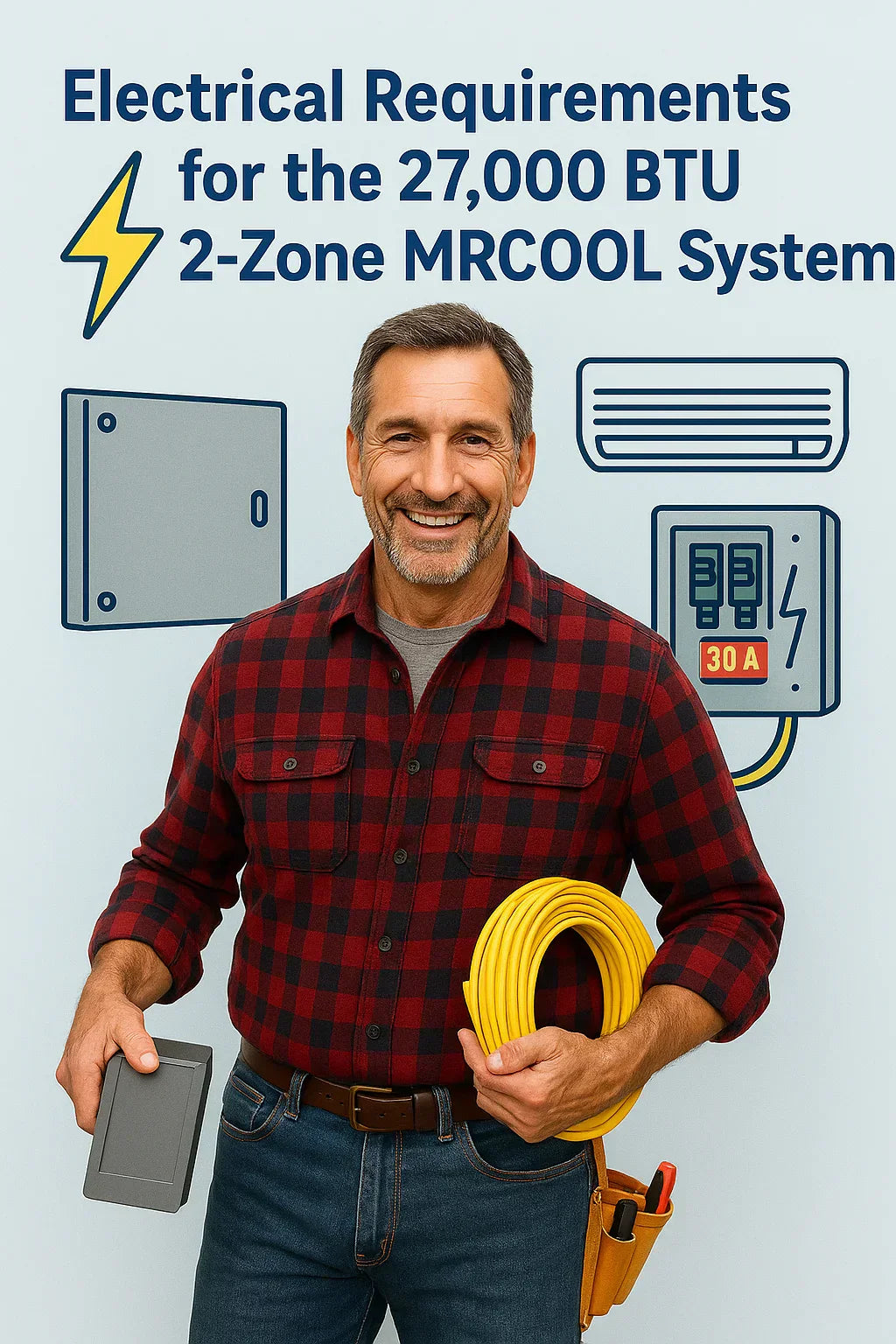1. ⚠️ Why Electrical Setup Matters
A safe and efficiently wired system delivers peak performance, prevents nuisance faults, and keeps insurance and warranty valid. Improper wiring can lead to:
-
Tripped breakers or blown fuses
-
Poor compressor startup or system cycling
-
Safety hazards like overheating or shocks
-
Voided manufacturer warranty
Taking your time planning the electrical ensures your MRCOOL DIY Mini-Split Series 5th Generation 27,000 BTU 2-Zone Wall Mounted 12K+18K Heat Pump System runs smoothly for years.
2. 📐 System Electrical Specs
Here are the official specs for the 5th Gen 27k 2-zone MRCOOL condenser:
-
Voltage: 208–230V, single-phase
-
Minimum Circuit Ampacity (MCA): ~15–18 A
-
Maximum Overcurrent Protection (MOCP): 30 A double-pole breaker
-
Indoor Heads: Low-voltage 24V communications only; no line voltage power needed
-
Power Draw:
-
12k head: ~4.8 A running current
-
18k head: ~7 A
-
Combined max startup inrush: ~20–22 A peak
-
3. 🔌 Breaker Size & Panel Planning
Choosing Your Breaker:
-
MoCP: Always use LES/CE breakers
-
For 18A MCA → 25 A breaker is minimum; however,
-
MRCOOL specifies a 30 A double-pole for conservative startup handling
-
Insert breaker in 240 V panel within 24 inches of the outdoor unit
Panel Capacity:
-
Check available spaces, bus amp rating, and main nip.
-
Use load calculation to ensure your panel can support the addition.
4. 🛠️ Wire Gauge & Type
Appropriate Cable:
-
NEC recommends using #10 AWG copper cable for a 30 A circuit.
-
Use THHN/THWN in conduit in non-residential or exposed areas.
-
NM-B #10 can be used in drywall-covered runs (check local code).
Conductor Conduct:
-
Use 3-conductor (2 hots + 1 ground).
-
Ground wire min: #10 Cu or #8 AL per NEC 250.122.
5. 🔒 Disconnect Box Requirements
A disconnect switch must be within 6 ft of the outdoor condenser:
-
Use a fused or non-fused AC-rated switch.
-
Must be accessible without tools and near the unit.
-
Must match or exceed MCA & bust circuits.
6. 🟢 Grounding & Safety Devices
Ground Requirements:
-
Connect grounding conductor to the provided ground screw on the condenser.
-
Ensure consistent grounding by connecting to the main panel's ground bus.
GFCI and Surge Protection:
-
GFCI not required if no user access on 240 V.
-
Surge Protector recommended—install at panel or outdoor box.
-
Lightning/surge protection can boost system longevity .
7. 🧭 Control Wiring Between Units
The communication cable shares minimal electrical but is vital:
-
Typically 5-pair alarm-style wire
-
Run through wall sleeve alongside line-sets
-
Connect to 1A–2A ports labeled indoors/outdoors
-
Don't extend more than 100 ft—avoid wireless gaps
-
Grounding happens only on indoor heads, not communication cable
8. 🛠️ Tools & Prep
Gather these before starting:
-
30 A double-pole breaker
-
#10 AWG cable and ground wire
-
Disconnect box and conduit
-
Wire strippers, torque & insulated screwdrivers, multimeter
-
Voltage tester, cable staples/anchors
-
Drill & weatherproof sealant
-
Labeling system for wires (heat-shrink markers)
9. 🚫 Common Mistakes to Avoid
| Mistake | Risk/Impact | Tip |
|---|---|---|
| Using #12 wire with 30 A breaker | Wire overheating & failure | Always use #10 AWG for 30 A circuits |
| Omitting disconnect switch | Fail to comply with NEC 440 | Install right outside the outdoor unit |
| Sharing breaker with other load | Risk of overload | Use dedicated circuit only |
| Using GFCI breakers for outdoor 240 V | Nuisance trips when running compressor start | Use non-GFCI breakers unless local code requires |
| Failing to torque lugs properly | Loose connections → overheating | Use torque screwdriver, check per specs |
| Not using proper cable type | Code violations and risk of damage | Confirm local building code for NM-B or conduit use |
10. ✅ Checklist
Use this to verify your wiring setup before powering up:
-
30 A 2‑pole breaker installed
-
#10 AWG copper wire used for hots & ground
-
Disconnect switch within 6 ft of unit
-
Ground connected properly
-
Torque specifications met
-
Control cable routed with line-sets
-
Panel and circuit labelled
-
Cable protected (staples/conduit) per code
11. 📚 Verified External References
-
MRCOOL Installation Manual, Section 4 – Electrical Requirements
-
NEC Code 440.14 – Motor Controllers & Disconnect Requirements
-
NEC Code 250.122 – Equipment Grounding Conductor Requirements
Final Recommendation
-
Install a dedicated 30 A breaker with #10 copper wire
-
Include a near-unit disconnect per code
-
Properly ground and use a surge suppressor
-
Run control cable correctly and securely
-
Follow NEC guidelines to ensure safety, warranty compliance, and longevity
In the next topic we will read more about: Is the MRCOOL 27,000 BTU 2‑Zone System Right for Your Home?







